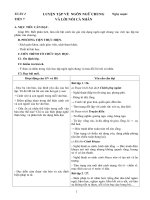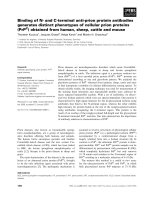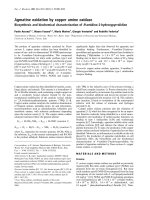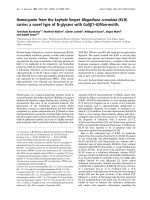Bull of N.Y. Museum Bulletin 90-1Cephalopods
Bạn đang xem bản rút gọn của tài liệu. Xem và tải ngay bản đầy đủ của tài liệu tại đây (4.18 MB, 91 trang )
NEW YORK STATE MUSEUM
Piloceras explanator Whitfield
Page 429
See pl.
II
A large specimen retaining the apical portion, which is broken
lengthwise and exhibits a section of the siphuncle; the latter
being filled with calcite. Above this the break shows the exterior of the siphuncle with the septal ribs. The upper part
retains the smooth exterior of the shell on the left side; and
on the right side a marginal section with the septa is shown..
The apparent irregularity of the septa is due to that of the break..
producing the section. A natural section of this specimen \5
reproduced on the next plate.
The original is from the Fort Cassin beds at Valcour N. Y..... and
nO\\7 in the New York State Museum.
I
PLATE
II
55°
NEW YORK STATE M.USEUM
Piloceras explanator Whitfield
Page
429
See pl.
I
10
Natural section of the specimen reproduced on plate
the siphuncle and part of the endosiphocone
10,
showing
PLATE
12
55 2
NEW YORI{ STATE MUSEUM
Orthocerasmodestum sp. nov.
Page 436
A natural section showing the siphuncle and the depth of the
cameras
2 Specimen retaining a cast of the living chamber and one camera.
Shows the size of the living chamber, its anterior contraction,
the depth of the septa and of the cameras
3 A living chamber with part of the outer wall, which is not constricted
The original of figure I is from the upper Chazy (C,') of the
neighborhood of Chazy; those of figures 2 and 3 are from the
dove-colored Chazy limestone (C l ) of the east shore of Valcour
island. They are now in the New York State Museum.
I
Geisonoceras shumardi Billings (sp.)
Page
437
4 A natural section showing the siphuncle and cameras
The original is from the middle Chazy (B 2 ) -of the neighborhood
of Chazy N. Y., and now in the New York State Museum.
Orthoceras progressum sp. nov.
Page
4.)4
5, 6 'Two views of the type; the former showing the rate of growth
and the sutures; the latter, in a section, the siphuncle, the depth
of the cameras and of the septa
The original is from the dove-colored upper Chazy limestone on
the east shore of Valcour island, and now in the N ew York State
Museum,
C E PI-IAL 0 POD S
Bull. 90 N.Y. S tate Museum
Pla te 12
3
(f, : " •
\"t~)j,"
6
G. S..Barkentin .del.
W.S. Barkentin.lit h.
PLATE 13
554
NEW YORK STATE MUSEUM
Orthoceras vagum sp. nov.
Page 435
See pl. 9, fig. 9
Two views of the type specimen showing its irregularly curving form, rate of growth, suture and depth of chambers
3 Natural section of another specimen, showing the siphuncle and
depth of septa
The original of figures I, 2 is from the dove-colored Chazy limestone of the east shore of Valcour island and now in the Ne\v
York State Museum; that of figure 3 is from' the same horizon on
Isle La Motte Vt., and now in the American Museum of Natural
History in New Yark.
I, 2
PLATE 14.
556
NEW YORK STATE MUSEUM
Orthoceras lentum sp. nov.
Page
433
3 External view and section of the type
.
Part of the section (x 2) to show more distinctly the character
of the siphuncular elements
The original is from the dove-colored Chazy limestone of Little
Monty bay and now in the New York State MUSeU1TI
I,
2
Spyroceras clintoni 1\1 iller (sp.)
Page 445
See pl. 16, fig. 4-7
4 Redrawing of Hall's type of 0 r tho c era s sub arc u a tum
(=== Spy roc era sci in ton i) figured in Palaeontology of
Neui York} volume I, plate 7, figure 3. Shows the composition
of the type specimen of fragments of two different species.
The original is in the American Museum of Natural History in
New York.
Orygoceras cornu-oryx Whitfield (sp.)
Page 450
5 Fragment showing the regular internal constrictions of the wall
of the conch, its rate of growth and the depth of the cameras
6 A specimen with slightly different character of the constrictions
7, 8 Specimen showing the smooth nonannulated outside of the wall.
The originals of figures 5, 7, 8 are from the Fort Cassin beds at
Fort Cassin and now in the museum of Burlington University;
that of figure 6 is from the same formation (A a ) at Valcour N. Y.
and now in the New York State Museum,
CEPI'L,-'-L() POD S
Plate 14
Bull ,90 NY S ta te Mu seum
G
.,
G.S . Be rken tin .del.
IJ
W S ,Barke nt m lith ,
PLATE 15
558
NEW YORK STATE MUSEUM
Protocycloceras lamarcki Billings (sp.)
Page 441
See pl. 16, fig.
I, 2
Fragment with narrow annulated and relatively wide interspaces.
Drawn from a gutta-percha squeeze
2;, 3 Two views of a specimen retaining in part the wall and showing the position and relative size. of the siphuncle
4 Natural section of a specimen. The septa are slightly curved in
the original.
5 Specimen showing a slight curvature of the conch and a more
central position of the siphuncle in the section. than the original
of figure 3.
6 A longitudinally striated fragment of a conch, found associated
with this species and presumably representing the apical part of
the same. Drawn from a gutta-percha squeeze
The originals of figures I and 6 are from the Beekmantown beds of
the Spelman ledge at Beekmantown; those of figures 2-5 from
the Fort Cassin beds at Valcour, figures 2, 3, 4 from As of the
section, figure 5 from A 5 • Originals are now in the N ew York
State Museum.
1
Protocycloceras whitfieldi sp. nov.
Page 443
7 The type of the species. A section of the same is reproduced in
text figure 17.
The original is from the Fort Cassin beds at Fort Cassin and now
in the museum of Burlington University.
CEPI-IA.L() POD S
Bull. 90 N.Y. State Museum
Plate 15
.,
OJ
(j
G. S. Berkentin .de l.
W.S .Barkentin.li th o
PLATE 16
NEW YORK STATE MUSEUM
Protocycloceras lamarcki Billings (sp.)
Page 441
See pl. IS, fig. 1-5
A specimen retaining the surface sculpture
Enlargement (x 3) of a portion of the sculpture of the same
specimen to show the alternation of striae
The original is from the Fort Cassin beds at Fort Cassin and now
in the New York State Museum.
I
2
Protocycloceras (?) cf. furtivum Billings (sp.)
Page 0445
3 A fragment showing the oblique direction of the annulations.
Drawn from a gutta-percha squeeze
The original is from the Beekmantown beds at the Spelman ledge
near Beekmantown N. Y. and now in the New York State
Museum.
Spyroceras clintoni Miller (sp.)
Page 445
See pl. 14, fig. 4
4 Natural section of a fragment, showing the curvature of the conch
and the depth of the cameras and of the septas. The siphuncle
is shown in the lower part
5 Natural section of a fragment showing the position of the siphuncle and the oblique direction of its inflations
6 Surface sculpture- of a fragment. Faint alternating longitudinal
lines are not brought out in the drawing
7 Apical part of a conch
The originals of figures 4, 6, 7 are from the dove-colored Chazy
limestone near Little Monty bay; that of figure 5 is from the
middle Chazy beds of the west shore of Valcour island. All are
now in the New York State Museum.
CEPI-IAL()PODS
Bull. 90 N.Y. State Museum
Plate 16
",
~'.
G.S. Berkentm .de l.
W.S.Barke ntin.lith .
PLATE 17
NEW YORK STATE MUSEUM
Eurystomites kelloggi Whitfield (sp.)
Page 456
See pl. 18, fig.
I
I Section of a mature specimen
The original is from bed As of the Fort Cassin beds at Valcour
N. Y., and now in the New York State Museum.
CEPI-IALOPOD S
Bull.90 N.Y. State Museum
G. S. Barkentin del.
Plate 17
W.S.Barkentin.lrth.
PLATE 18
NEW YORK STATE MUSEUM
Eurystomites kelloggi Whitfield (sp.)
Page 456
See pl. 17, fig. 1
I
Fragment of shell showing the coarse striae and rugae of the
surface. The fragment is in a crushed condition. It comes
from bed A a of the Fort Cassin beds (Beekmantown formation)
at Valcour, and is now in the New York State Museum.
Eurystomites accelerans sp. nov.
Page
2
460
Lateral view of. the type
3 View of a part of the flat ventral side of the same specimen
The original is from the Fort Cassin beds (As) of the Valcour section and .now in the N ew York State Museum.
Eurystomites amplectens sp. nov.
Page
461
4, 5 Two views of the type. Figure 4 slightly restored in the lower
part
6, 7 Two views of the first chamber with the cicatrix and surface
sculpture
The original is from the Fort Cassin beds (A 5 ) of the Valcour section and now in the New York State Museum,
CEPI-L"'-I... () POD S
Bull. 90 N .Y. State Museum
Plate 18
4
3
,-
, ~\
,
.
\
6
a
"
-,
<,
,,
\
\
\
\
\
\
\
\
\
I
I
I
J
I
'/
I
I
I
I
I
/
/
i} ' /
!V /
/
;1' /
/
/
G,S, Barkenu n .de l,
WS .Barke ntin .l uh
PLATE 19
566
NEW YORK STATE MUSEUM
Tarphyceras seelyi Whitfield (sp.)
Page 465
See' pl.
20,
fig. 5; pl.
21;
pl.
24,
fig. 3
Transverse section of a specimen, obtained by fracturing and
showing the septa and siphonal perforations.
A lateral view
of this specimen is shown on plate.aa, figure 3. .
2 Lateral view of a living chamber. The posterior part is partly
crushed
The originals are from the Fort Cassin beds (As) of Valcour N. Y.,
and now in the New York State Museum.
I
Tarphyceras multicameratum sp. nov.
Page
472
See pl. 23, fig. 2
3 The early volutions of the type specimen, the other side of which
is shown on plate 23, figure 2
The original is from the dove-colored Chazy limestone of Isle La
'Motte and now in the museum of Burlington University.









